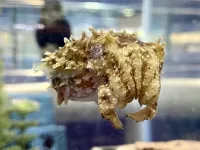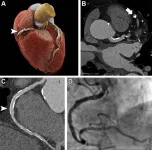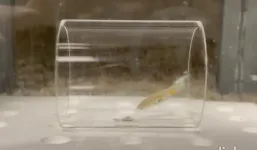(Press-News.org) There's a bouncer in everyone: The blood-brain barrier, a layer of cells between blood vessels and the rest of the brain, kicks out toxins, pathogens and other undesirables that can sabotage the brain's precious gray matter.
When the bouncer is off its guard and a rowdy element gains entry, a variety of conditions can crop up. Barrier-invading cancer cells can develop into tumors, and multiple sclerosis can occur when too many white blood cells slip pass the barrier, leading to an autoimmune attack on the protective layer of brain nerves, hindering their communication with the rest of the body.
"A leaky blood-brain barrier is a common pathway for a lot of brain diseases, so to be able to seal off the barrier has been a long sought-after goal in medicine," said Calvin Kuo, MD, PhD, the Maureen Lyles D'Ambrogio Professor and a professor of hematology.
Methods of repairing the blood-brain barrier remain understudied, according to Kuo. But a recent paper he and colleagues led describes a treatment that could be instrumental in restoring the barrier's normal function. Kuo is the senior author of the paper, published in Nature Communications on June 2.
"We have evaluated a new therapeutic class of molecules that can be used to treat a leaky blood-brain barrier; previously, there were no treatments directed at the blood-brain barrier specifically," Kuo said.
The researchers started their quest by looking at WNT signaling, a communication pathway used by cells to promote tissue regeneration and wound healing. WNT signaling helps maintain the blood-brain barrier by promoting cell-to-cell communication that lines brain blood vessels.
"There's a lot of historical data that indicated that the WNT signaling pathway would be important for maintaining the blood-brain barrier," Kuo said. "The opportunity arose to test a novel WNT signaling pathway that would turn on signaling in the blood-brain barrier by binding very selectively to a receptor called frizzled."
Scientists have been focusing on frizzled, a protein receptor that initiates the WNT pathway, for blood-brain barrier therapies since mouse mutations in the frizzled gene cause blood-brain barrier abnormalities.
How it's made
Many different molecules bind to frizzled protein receptors, so to narrow their search for a potential therapeutic molecule, the researchers selected only those that specifically target cells that line the brain's blood vessels.
Chris Garcia, PhD, a professor of molecular and cellular physiology as well as the Younger Family Professor, developed prototype therapeutic WNT pathway molecules in the lab, including a molecule that activates the frizzled receptor FZD4. Building off of the work of Garcia and Kuo, collaborators at a research company created L6-F4-2, a FZD4 binding molecule that activates WNT signaling 100 times more efficiently than other FZD4 binders.
When the team, including Jie Ding, a research scientist and the lead author of the paper, activated WNT signaling at a higher rate, they saw an increase in blood-brain barrier strength.
Keeping the bouncer on duty
The researchers wanted to study what happens when the natural molecular key for frizzled is missing, and whether it can be replaced successfully with L6-F4-2. So they turned to Norrie disease, a genetic abnormality that results in a leaky blood-retinal barrier.
The blood-retinal barrier performs the same function for the eye as the blood-brain barrier does for the brain. In Norrie disease, the development of blood vessels of the retina -- the layer of light-sensitive cells in the back of the eye -- is hindered, resulting in leaky blood vessel connections, improper development and blindness.
Norrie disease results from mutations in the NDP gene, which provides instructions for making a protein called Norrin, which is the key that fits the lock of the FZD4 receptor and turns it on. In the study's mice, the gene is inactivated, and the key is missing causing a leaky barrier and blindness. The scientists replaced the missing Norrin protein with L6-F4-2, which they call a surrogate.
When L6-F4-2 replaced the missing Norrin protein, the blood-retinal layer was restored in the mice. Researchers knew this because they imaged the blood vessels and found them to be denser, and less leaky, than before treatment. Scientists also showed that, for the blood-brain barrier surrounding the mice cerebellum -- a region responsible for muscle coordination -- L6-F4-2 replaced Norrin and activated WNT signaling.
Next, the researchers wanted to study a more common human condition -- ischemic stroke (in which blood vessels and the blood-brain barrier are damaged, and fluid, blood and inflammatory proteins involved in cellular communication can leak into the brain. They found that L6-F4-2 reduced the severity of stroke and improved survival of mice compared with mice that had untreated strokes. Importantly, L6-F4-2 reversed the leakiness of brain blood vessels after stroke. Mice treated with L6-F4-2 had increased stroke survival, compared to those that were not treated.
The finding shows that, in mice, the blood-brain barrier could be restored by drugs that activate FZD receptors and the WNT signaling pathway.
Because a variety of disorders have their origin in blood-brain barrier dysfunction, Kuo is excited about the treatment potential for a variety of other neurological diseases, such as Alzheimer's, multiple sclerosis and brain tumors.
"We hope this will be a first step toward developing a new generation of drugs that can repair the blood-brain barrier, using a very different strategy and molecular target than current medications," Kuo said.
END
Restoring the blood-brain barrier?
Blood-brain barrier
2023-06-20
ELSE PRESS RELEASES FROM THIS DATE:
Combining cancer-targeting virus therapy with radiation to fight brain cancer works better than either treatment on its own: study
2023-06-20
EDMONTON — Combining a cancer-targeting virus with radiation to treat brain cancer in mice was more effective than either therapy on its own according to University of Alberta research, providing hope for new treatments that combine immunotherapy with traditional surgery, chemotherapy or radiation.
The researchers treated mice with glioblastoma brain tumours simultaneously with high-dose radiation and a genetically engineered oncolytic vaccinia virus, a virus that has been used safely as a vaccine against smallpox.
The ...
Exploring the deep connections between adolescent sleep and overall health
2023-06-20
As director of SRI’s Human Sleep Research Program, Fiona Baker studies the complex interplay between sleep and overall health and well-being.
Much of her work has been focused on sleep patterns in adult women, but recently her attention has turned to adolescents. Adolescence is a crucial time for developing healthy sleep patterns as it is for brain development. In her research, Baker draws clear lines of connection between the two.
“Sleep is so important to us all, but especially for teenagers or adolescents,” Baker says. “Between the ages of 10 and 21, or so, and even a little later, the ...
SRI seeks to learn how insects speak through smells
2023-06-20
All around us, insects are speaking to each other: jockeying for mates, searching for food, and trying to avoid becoming someone else’s next meal. Some of this communication is easy to spot—like the flashes of fireflies on a summer night or a screaming chorus of cicadas in the afternoon—but many of the most sophisticated conversations are challenging to observe, occurring through an exchange of chemical scents.
Understanding chemical communication could be the key to finding new, more effective ways to protect crops or ward off biting insects that can transmit diseases. Researchers ...
Cuttlefish brain atlas first of its kind
2023-06-20
NEW YORK, NY — Anything with three hearts, blue blood and skin that can change colors like a display in Times Square is likely to turn heads. Meet Sepia bandensis, known more descriptively as the camouflaging dwarf cuttlefish. Over the past three years, a team led by neuroscientists at Columbia’s Zuckerman that includes data experts and web designers has put together a brain atlas of this captivating cephalopod: a neuroanatomical roadmap depicting for the first time the brain’s overall 32-lobed structure as well its cellular organization.
The ...
Climate action plans mobilize limited urban change, researchers report
2023-06-20
The Intergovernmental Panel on Climate Change Fifth Assessment Report (AR5), released just prior to an international climate convention in 2015, explicitly stated that human-caused greenhouse gas emissions were the highest in history, with clear and widespread impacts on the climate system. Since then, hundreds of cities across the world have published their own climate action plans (CAPs), detailing how their urban areas will handle climate change. How do the plans stack up against one another and against the recommended ...
Photon-counting CT noninvasively detects heart disease in high-risk patients
2023-06-20
OAK BROOK, Ill. – New ultra-high-resolution CT technology enables excellent image quality and accurate diagnosis of coronary artery disease in high-risk patients, a potentially significant benefit for people previously ineligible for noninvasive screening, according to a study published in Radiology, a journal of the Radiological Society of North America (RSNA).
Coronary artery disease is the most common form of heart disease. Coronary CT angiography (CCTA) is highly effective for ruling out coronary artery disease ...
Self-driving revolution hampered by a lack of accurate simulations of human behavior
2023-06-20
Self-driving revolution hampered by a lack of accurate simulations of human behaviour
Algorithms that accurately reflect the behaviour of road users - vital for the safe roll out of driverless vehicles - are still not available, warn scientists.
They say there is “formidable complexity” in developing software that can predict the way people behave and interact on the roads, be they pedestrians, motorists or bike riders.
To improve the modelling, a research team led by Professor Gustav Markkula from the Institute of Transport Studies ...
Toxic emissions from wildland-urban interface fires
2023-06-20
Fires in the wildland-urban interface (WUI) emit more toxic smoke than wildfires burning in natural vegetation, due to the chemicals in the structures, vehicles, and other manufactured goods that burn in fires in areas of human habitation. Amara Holder and colleagues surveyed the literature on emissions from urban fuels, finding 28 experimental studies that reported emission factors—emissions per unit of fuel burned—for various items, such as home furnishings, consumer electronics, and vehicle ...
Electing progressives with patriotism, family, and tradition
2023-06-20
Economically progressive candidates may fare better in US elections when delivering their message in terms of “binding values” such as patriotism, family, and respect for tradition, according to a study. Although large majorities of Americans favor increasing economic equality in the United States, candidates who promote policies intended to reduce economic inequality, such as raising the minimum wage or increasing access to health care, often fare poorly at the ballot box. One reason for their under-performance may ...
Locating executive functions in fish brains
2023-06-20
The telencephalon is the part of the brain responsible for executive functions in fish, according to an experimental study. Zegni Triki and colleagues used guppies (Poecilia reticulata) that had been selected over five generations to have smaller or larger telencephalons, resulting in a 10% size difference between “up selected” and “down selected” lines of fish. Total brain size was not significantly affected. The authors then presented 48 male fifth-generation fish from both lines with tests of cognitive flexibility, inhibitory control, and working memory—the three commonly accepted components ...
LAST 30 PRESS RELEASES:
Exposure to natural light improves metabolic health
As we age, immune cells protect the spinal cord
New expert guidance urges caution before surgery for patients with treatment-resistant constipation
Solar hydrogen can now be produced efficiently without the scarce metal platinum
Sleeping in on weekends may help boost teens’ mental health
Study: Teens use cellphones for an hour a day at school
After more than two years of war, Palestinian children are hungry, denied education and “like the living dead”
The untold story of life with Prader-Willi syndrome - according to the siblings who live it
How the parasite that ‘gave up sex’ found more hosts – and why its victory won’t last
When is it time to jump? The boiling frog problem of AI use in physics education
Twitter data reveals partisan divide in understanding why pollen season's getting worse
AI is quick but risky for updating old software
Revolutionizing biosecurity: new multi-omics framework to transform invasive species management
From ancient herb to modern medicine: new review unveils the multi-targeted healing potential of Borago officinalis
Building a global scientific community: Biological Diversity Journal announces dual recruitment of Editorial Board and Youth Editorial Board members
Microbes that break down antibiotics help protect ecosystems under drug pollution
Smart biochar that remembers pollutants offers a new way to clean water and recycle biomass
Rice genes matter more than domestication in shaping plant microbiomes
Ticking time bomb: Some farmers report as many as 70 tick encounters over a 6-month period
Turning garden and crop waste into plastics
Scientists discover ‘platypus galaxies’ in the early universe
Seeing thyroid cancer in a new light: when AI meets label-free imaging in the operating room
Neutrophil-to-lymphocyte ratio may aid risk stratification in depressive disorder
2026 Seismological Society of America Annual Meeting
AI-powered ECG analysis offers promising path for early detection of chronic obstructive pulmonary disease, says Mount Sinai researchers
GIMM uncovers flaws in lab-grown heart cells and paves the way for improved treatments
Cracking the evolutionary code of sleep
Medications could help the aging brain cope with surgery, memory impairment
Back pain linked to worse sleep years later in men over 65, according to study
CDC urges ‘shared decision-making’ on some childhood vaccines; many unclear about what that means
[Press-News.org] Restoring the blood-brain barrier?Blood-brain barrier





